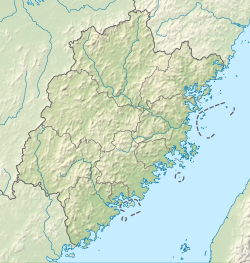Mount Qingyuan: Difference between revisions
→See also: already linked in article |
m →External links: copyedit, already indirectly in category, refine cat, and AWB general fixes using AWB |
||
| Line 31: | Line 31: | ||
==External links== |
==External links== |
||
*{{Official|http://www.qingyuanmount.com website}} |
*{{Official website|http://www.qingyuanmount.com website}} |
||
*[http://www.fjqz.gov.cn/ Quanzhou Government Website] |
*[http://www.fjqz.gov.cn/ Quanzhou Government Website] |
||
{{National parks of China}} |
{{National parks of China}} |
||
[[Category: |
[[Category:Landforms of Fujian]] |
||
[[Category:National parks of China|Qingyuan]] |
[[Category:National parks of China|Qingyuan]] |
||
[[Category:Mountians of China]] |
|||
[[Category:Visitor attractions in Fujian]] |
[[Category:Visitor attractions in Fujian]] |
||
Revision as of 18:55, 23 November 2014
| Mount Qingyuan | |
|---|---|
 Stone statue of Laozi at the foot of Mount Qingyuan | |
| Highest point | |
| Elevation | 498 m (1,634 ft) |
| Geography | |
| Standort | near Quanzhou, Fujian, China |
Mount Qingyuan (Chinese: 清源山; pinyin: Qīngyuán Shān) is a national park in Fujian, People's Republic of China, located about 3 km (1.9 mi) from Quanzhou city. It consists of three scenic spots. They are Mount Qingyuan, Mount Ling and Mount Jiuri. The total area covered is 62 km2 (24 sq mi). It is 498 m (1,634 ft) above sea level.
History
Mount Qingyuan has been famous since the Tang dynasty. The earliest mention of Mount Qingyuan is from around 221-207 BCE. Rapid development of Mount Qingyuan began in 618-1279 CE and reached its peak during 1297 to 1911.
The centuries of development on Mount Qingyuan has imprinted various important historical and cultural artifacts. Such examples include nine huge Taoist and Buddhist stone sculptures, 600 stone inscriptions and 3 granite stones. The site also contain the shrine of Master Honyi.
There are also the "Four Superlatives" which include the stone statue of Laozi from the Song Dynasty, the Vedic stone statues of Buddha for Three Lives, the holy Islamic tombs and the pray for wind stone inscriptions.[1]

